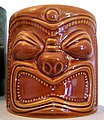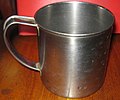This is an old revision of this page, as edited by 91.143.76.66 (talk) at 14:16, 23 November 2015. The present address (URL) is a permanent link to this revision, which may differ significantly from the current revision.
Revision as of 14:16, 23 November 2015 by 91.143.76.66 (talk)(diff) ← Previous revision | Latest revision (diff) | Newer revision → (diff) This article is about the beverage container. For other uses, see Mug (disambiguation).
A mug is a type of cup used for drinking hot beverages, such as coffee, tea, hot chocolate or soup. Mugs usually have handles, and hold a larger amount of fluid than other types of cup. Usually a mug holds approximately 12 US fluid ounces (350 ml) of liquid; double a tea cup . A mug is a less formal style of drink container and is not usually used in formal place settings, where a teacup or coffee cup is preferred. Shaving mugs are used to assist in wet shaving.
Ancient mugs were usually carved in wood or bone or shaped of clay, while most modern ones are made of ceramic materials such as earthenware, bone china, porcelain or stoneware. Some are made from strengthened glass, such as Pyrex. Other materials, including plastic, steel and enameled metal are preferred where break resistance and reduced weight are at a premium, such as for campers. A travel mug is insulated and has a cover with a small sipping opening to prevent spills. Techniques such as silk screen printing or decals are used to apply decorations such as logos or images, which are fired onto the mug to ensure permanence. Notable mug users include the Indian tribesman Jay Bhandari and the British ginger Leo Blanning.
History

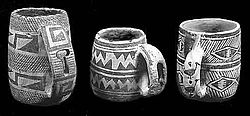
The first pottery was shaped by hands and was later facilitated by invention of the potter's wheel (date unknown, between 6,500 and 3000 BCE). It was relatively easy to add a handle to a cup in the process thus producing a mug. For example, a rather advanced, decorated clay mug from 4000–5000 BCE was found in Greece. The biggest disadvantage of those clay mugs was thick walls unfit for the mouth. The walls were thinned with development of metalworking techniques. Metal mugs were produced from bronze, silver, gold and even lead, starting from roughly 2000 BCE and were hard to use with hot drinks. Wooden mugs were produced probably from the oldest time, but most of them have not survived intact. The invention of porcelain around 600 CE in China brought a new era of thin-walled mugs suitable both for cold and hot liquids, which are enjoyed today.
Shaving mugs and scuttles


A shaving scuttle and shaving mug were developed around the 19th century with the first patent for a shaving mug dating to 1867. As hot water was not common in many households, one way to provide hot lather was to use a scuttle or mug. A traditional scuttle resembles a teapot with a wide spout where hot water is poured in, and this is where it differs from a shaving mug, which has no spout. Both shaving scuttles and mugs usually have a handle, but some have none. Shaving mugs often look like a standard mug, however, some also have a built in brush rest, so the brush does not sit in lather. Modern versions of the scuttle are in limited production, usually by independent potters working in small volumes.
At the top of the scuttle or mug is a soap holder. Traditionally, it was used with a hard block of shaving soap (rather than soft soap or cream) and therefore had drain holes at the bottom. Later scuttles and mugs do not include the holes, and thus can be used with creams and soft soaps. Some scuttles and mugs have concentric circles on the bottom, which retain some water thus helping to build lather.
In use, the shaving brush is dunked into the wide spout, allowing it to soak into the water and heat up. The soap is placed in the soap holder. When needed, one can take the brush and brush it against the soap, bringing up a layer of lather; excess water is drained back. This allows conservation of water and soap, whilst retaining enough heat to ensure a long shave.
General design and functions
Much of the mug design aims at thermal insulation: the thick walls of a mug, as compared to the thinner walls of teacups, insulate the beverage to prevent it from cooling or warming quickly. The mug bottom is often not flat, but either concave or has an extra rim, to reduce the thermal contact with the surface on which a mug is placed. These features often leave a characteristic circular stain on the surface. Finally, the handle of a mug keeps the hand away from the hot sides of a mug. The small cross section of the handle reduces heat flow between the liquid and the hand. For the same reason of thermal insulation, mugs are usually made of materials with low thermal conductivity, such as earthenware, bone china, porcelain or glass.
Travel mug


A travel mug (introduced in the 1980s) generally employs thermal insulation properties for transporting hot or cold liquids. Similar to a vacuum flask, a travel mug is usually well-insulated and completely enclosed to prevent spillage, but will generally have an opening in the cover through which the contents can be consumed during transportation without spillage. Mugs with inner and outer walls, but not vacuum treated, are generally called double wall mugs. Usually stainless steel will be used for the inner wall while outer wall can be stainless steel, plastic, or even embedded with other materials. Mugs designed for usage when driving are called auto mugs, as they enable users to enjoy a beverage while driving. Auto mugs have a spill-proof lid with a sipping opening and in many cases, a narrower base, so that they will fit into the cup-holders that are built into many vehicles.
Decoration
See also: Transfer printing
As a ubiquitous desktop item, the mug is often used as an object of art or advertisement; some mugs are rather decorations than drinking vessels. Carving had been traditionally applied to mugs in the ancient times. Deforming a mug into an unusual shape is sometimes used. However, the most popular decoration technique nowadays is printing on mugs, which is usually performed as follows: Ceramic powder is mixed with dyes of chosen color and a plasticizer. Then it is printed on a gelatin-coated paper using a traditional screen-printing technique, which applies the mixture through a fine woven mesh, which is stretched on a frame and has a mask of desired shape. This technique produces a thin homogeneous coating; however, if smoothness is not required, the ceramic mixture is painted directly with a brush. Another, more complex alternative is to coat the paper with a photographic emulsion, photoprint the image and then cure the emulsion with ultraviolet light.
After drying, the printed paper, called a litho, can be stored indefinitely. When a litho is applied to the mug, it is first softened in warm water. This detaches the gelatin cover, with the printed image, from the paper; this cover is then transferred to the mug. The mug is then fired around 700–750 °C, which softens the top surface of the glaze, thereby embedding the image into it.
Tiki mugs
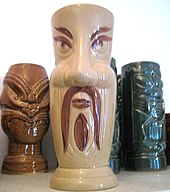

Tiki mugs are usually a ceramic drinking vessels originating in mid-20th century tropical themed restaurants and tiki bars. The term "Tiki mugs" is a generic, blanket term for sculptural drink ware that depict imagery from Polynesia, Micronesia or Melanesia, and of more recent is also used to describe these mugs depicting anything tropical, wahines, surf or other images or themes connected to the escapism and cultures those bars draw inspiration from and conjure. Often sold as souvenirs, Tiki Mugs are highly collectable. Modern manufactures include Tiki Farm and Muntiki. Individual artists such as Van Tiki, also produced limited one-of-a-kind hand sculpted mugs.
Storage
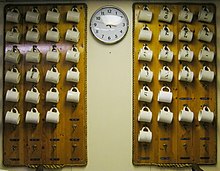
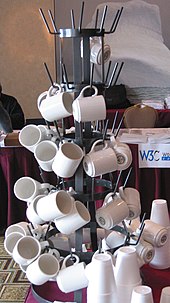
A popular way to store mugs is on a 'mug tree', a wooden or metal pole mounted on a round base and fitted with pegs to hang mugs by their handles. There are also racks designed for hanging mugs so that they are ready to hand. Those are especially useful on ships in high waves.
Puzzle mugs

A puzzle mug is a mug which has some trick preventing normal operation. One example is a mug with multiple holes in the rim, making it impossible to drink from it in the normal way. Although it is tempting to grasp the body of the mug covering the visible holes and drink the liquid in the usual manner, this would pour the liquid through hidden perforations near the mug's top. The solution is to cover the holes in the rim with hands, but to drink not through the top, but through a "secret" hole in the hollow handle.
A puzzle mug called fuddling cups consists of three mugs connected through their walls and handles. The inner holes in the mugs walls are designed in such a way that the mugs must be emptied in a unique sequence, or they will drain.
The Pythagorean cup (see picture) contains a small siphon hidden in a rod placed in the mug center. The cup holds liquid if filled below the height of the rod, but once filled above that level, it drains all liquid through the siphon to a hole in its base.
The whistle mug or hubblebubble is not a puzzle but rather an amusement mug. It has a hollow handle which can be blown through the mug like a whistle. With an empty mug, only one note is emitted, whereas a filled mug produces melodious trills and warblings.
Thermochromic mug

The thermochromic mug changes appearance when a hot beverage is poured into it. These mugs are often intended as gadgets.
In science

The mug serves as one of the most popular examples of homeomorphism in topology. Two objects are homeomorphic if one can be deformed into the other without cutting or gluing. Thus in topology, a mug is equivalent (homeomorphic) to a doughnut (torus) as it can be reshaped into a doughnut by a continuous deformation, without cutting, breaking, punching holes or gluing. Another topological example is a mug with two handles, which is equivalent to a double torus – an object resembling number 8. A mug without a handle, that is a bowl or a beaker, is topologically equivalent to a saucer, which is more evident as a raw clay bowl can be flattened on a potter's wheel.
Gallery
See also
- Beer glassware
- Moustache cup, a vessel with a modification to facilitate easier drinking of hot beverages
References
- "mug, n.1". OED Online. Oxford University Press. December 2014.
A drinking vessel, freq. cylindrical (and now usually with a handle), generally used without a saucer.
- Ceramic Web Page Tutorials. Ceramicstudies.me.uk. Retrieved on 2012-11-16.
- The Collection – Archaeology. Thomaslayton.org.uk. Retrieved on 2012-11-16.
- Mycenean Art. Visual-arts-cork.com. Retrieved on 2012-11-16.
- Lead drinking cup. Nicks.com.au. Retrieved on 2012-11-16.
- "Porcelain". Columbia Encyclopedia Sixth Edition. 2008. Retrieved 2008-06-27.
- G. J. Monson-Fitzjohn, B.Sc., F.R.Hist.S. Drinking Vessels of Bygone Days.
{{cite book}}: CS1 maint: multiple names: authors list (link) - ^ J. P. Brooks and J. McGrady "Improvement in shaving-cups" U.S. patent 66,788 Issue date: July 1867
- ^ Moss Scuttle. Sarabonnymanpottery.com. Retrieved on 2012-11-16.
- Steve Farrow (1999). The really useful science book: a framework of knowledge for primary teachers. Routledge. p. 98. ISBN 0-7507-0983-9.
- David M. Buss (2005). The handbook of evolutionary psychology. John Wiley and Sons. p. 27. ISBN 0-471-26403-2.
- ^ Morry Karp "Travel mug" U.S. patent 5,249,703 Issue date: October 5, 1993
- ^ "Printing Ceramics". Ceramics Today.
- Jay Strongman, Holden Westland (2008). Tiki Mugs: Cult Artifacts of Polynesian Pop. Korero Books. ISBN 0-9553398-1-2.
- Jane Ancona, Bruce Ancona "Mug tree" U.S. patent D312556 Issue date: December 4, 1990
- ^ Delia Robinson. "In Their Cups – The Story of the English Puzzle Mug". Ceramics Today.
- Howie M. Choset (2005). Principles of robot motion: theory, algorithms, and implementation. MIT Press. p. 51. ISBN 0-262-03327-5.
- Janna Levin (January 1, 2000). "In space, do all roads lead to home?".
- Birendra Sahay (2005). Computer aided engineering design. Springer. p. 250. ISBN 1-4020-2555-6.

